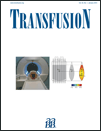Four-dimensional temperature distributions in red blood cells withdrawn from storage and exposed to ambient temperature: a magnetic resonance thermometry study
Abstract
BACKGROUND: Recommended by current guidelines, red blood cell (RBC) temperature should not exceed 10°C during transport. Since warming is a generically three-dimensional process that is not homogeneous, it is necessary to clarify the term “temperature during warming.” The purpose of this study was therefore to investigate laws and relations between surface, mean, and core temperature and the corresponding times when they exceed 10°C during warm-up.
STUDY DESIGN AND METHODS: Time-resolved three-dimensional temperature distributions of 53 resuspended RBC units (mean volume, 253 ± 17 mL) were measured noninvasively by magnetic resonance thermometry. Warm-up temperature maps were visualized and analyzed by dedicated software.
RESULTS: Mean times when surface, mean, and core temperature exceeded 10°C were 16 ± 4, 24 ± 5, and 36 ± 7 minutes, respectively. Times strongly correlated with each other (r = 0.78-0.95) and their variances mainly depended on RBC storage temperature and RBC pouch width (R2 = 0.81-0.89). Measured mean temperature time courses were well described by a lumped capacitive model of heat transfer with a sample width-dependent time constant τRBC = 56.3 ± 3.5 minutes (mean R2 = 0.996).
CONCLUSION: Times when RBC surface, mean, and core temperature exceed 10°C can be estimated from each other. Moreover RBC mean temperature can be calculated for arbitrary storage and ambient temperatures. Findings might serve as a helpful tool in RBC temperature monitoring.




